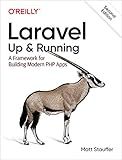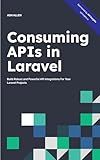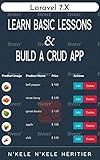Best Laravel to Vue.js Integration Solutions to Buy in October 2025

Laravel: Up & Running: A Framework for Building Modern PHP Apps



Consuming APIs in Laravel: Build Robust and Powerful API Integrations For Your Laravel Projects With Ease



Laravel 7.X : LEARN BASIC LESSONS & BUILD A CRUD APP (PHP Framework)


To send data from a Laravel controller to Vue.js, you can use the JSON response from the controller. In your Laravel controller, you can fetch the data from the database or any other source and return it as a JSON response using the json method.
For example, in your controller method:
public function getData() { $data = YourModel::all();
return response()->json($data);
}
Then, in your Vue.js component, you can make an AJAX request to the route that points to the controller method to fetch the data. You can use libraries like axios or Vue Resource to make the AJAX request and then bind the data to your Vue instance to display it on the frontend.
For example, in your Vue.js component:
By following these steps, you can easily send data from a Laravel controller to Vue.js and display it on the frontend of your application.
What is the best practice for structuring data objects in Laravel for Vue.js consumption?
One of the best practices for structuring data objects in Laravel for Vue.js consumption is to use API resources. API resources allow you to transform your Eloquent models into a format that is easily consumable by your Vue.js frontend.
To use API resources, you can create a new resource class for each of your Eloquent models. Inside the resource class, you can define which attributes should be exposed to the frontend, as well as any additional formatting or transformation that needs to be done.
You can then use these resource classes in your Laravel controllers to return the transformed data as JSON responses. This way, you can ensure that your Vue.js frontend receives clean and structured data objects that are optimized for consumption.
Additionally, you can also consider using the Fractal package to further enhance the way you structure data objects in Laravel for Vue.js consumption. Fractal allows you to easily serialize your data and include relationships between your models, making it easier to build more complex data structures for your frontend.
What is the significance of using APIs for data transfer between Laravel and Vue.js?
Using APIs for data transfer between Laravel and Vue.js offers several significant benefits:
- Separation of concerns: By using APIs, you can separate the front-end (Vue.js) and back-end (Laravel) of your application. This allows for better organization of code and makes it easier to maintain and update different parts of the application.
- Scalability: APIs enable you to scale your application by allowing different parts of the system to communicate with each other independently. This makes it easier to add new features or modules to your application without having to make significant changes to the existing codebase.
- Reusability: APIs promote code reusability by enabling different front-end or back-end components to interact with each other through standardized interfaces. This can reduce development time and effort, as developers can leverage existing APIs to build new features.
- Security: APIs provide a secure way to transfer data between different parts of the application. By using APIs, you can control access to your data and ensure that only authorized users have the ability to interact with your application.
Overall, using APIs for data transfer between Laravel and Vue.js can improve the performance, scalability, and security of your application, while also promoting code reusability and separation of concerns.
How can I implement data transfer between Laravel and Vue.js?
To implement data transfer between Laravel and Vue.js, you can use Vue.js to make AJAX requests to retrieve data from your Laravel backend. Here are the steps to implement this:
- Set up your Laravel backend to handle API requests: Create routes in your Laravel routes file that will handle the API requests from your Vue.js front end. You can use Laravel's built-in API routes feature to set up these routes.
- Create controllers in your Laravel backend: Create controllers that will handle the logic for retrieving and returning data in response to the API requests. You can use Laravel's built-in resources controllers feature to easily create these controllers.
- Use Axios in your Vue.js front end: Use the Axios library in your Vue.js components to make AJAX requests to your Laravel backend. You can use Axios to make GET, POST, PUT, and DELETE requests to fetch and send data.
- Handle the API responses in your Vue.js components: Once you receive a response from your Laravel backend, you can handle the data in your Vue.js components and display it to the user. You can use Vue.js data properties to store the data retrieved from the backend and bind it to your templates for rendering.
By following these steps, you can implement data transfer between your Laravel backend and Vue.js front end effectively. Remember to handle error responses and implement proper error handling mechanisms to ensure a smooth data transfer process.
What is the difference between one-way and two-way data binding in Laravel and Vue.js?
One-way data binding means that the data is bound in one direction only – from the model to the view or vice versa. In Laravel, one-way data binding typically involves passing data from the controller to the view using Blade templating.
On the other hand, two-way data binding means that changes in the model are immediately reflected in the view, and vice versa. In Vue.js, two-way data binding can be achieved through the use of v-model directive, which binds input or form values to data properties in the Vue instance.
In summary, the main difference between one-way and two-way data binding is the direction in which data flows – one-way data binding is unidirectional, while two-way data binding is bidirectional.
How can I structure my data in Laravel to make it compatible with Vue.js?
There are several ways to structure your data in Laravel to make it compatible with Vue.js. Here are some common practices:
- Use Laravel API routes: Create API routes in Laravel to expose your data as JSON endpoints that Vue.js can interact with. You can use Laravel's built-in API resources to transform your data into a format that is easily consumable by Vue.js.
- Use Laravel's built-in pagination features: If you have a large amount of data to display in your Vue.js application, you can use Laravel's pagination features to split the data into smaller chunks that can be loaded dynamically as the user navigates through the application.
- Use Laravel's Eloquent ORM: Use Laravel's Eloquent ORM to retrieve and manipulate data from your database. Eloquent makes it easy to define relationships between your data models and retrieve data in a way that is compatible with Vue.js.
- Use Laravel's Blade templating engine: You can use Laravel's Blade templating engine to generate HTML templates that are rendered on the server side and passed to Vue.js for dynamic manipulation. This can help improve performance and reduce the amount of data that needs to be transferred between the server and client.
By structuring your data in these ways, you can ensure that your Laravel application is compatible with Vue.js and can take advantage of its powerful features for building interactive web applications.
What is the JSON format for transferring data from Laravel to Vue.js?
{ "data": [ { "id": 1, "name": "John Doe", "email": "johndoe@example.com" }, { "id": 2, "name": "Jane Smith", "email": "janesmith@example.com" } ] }
